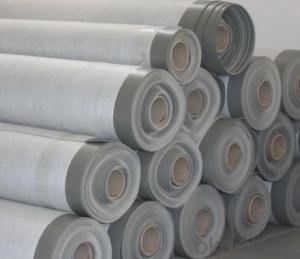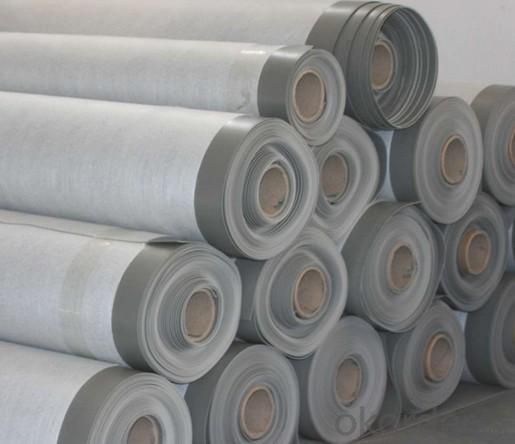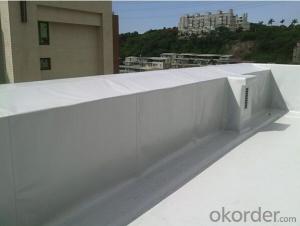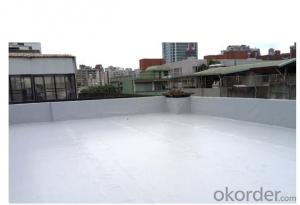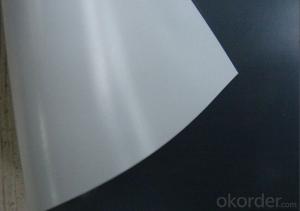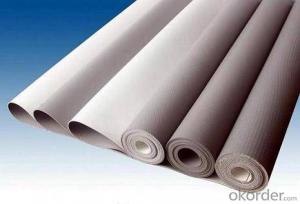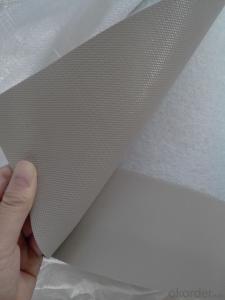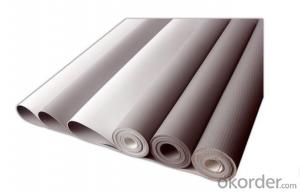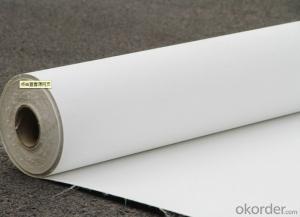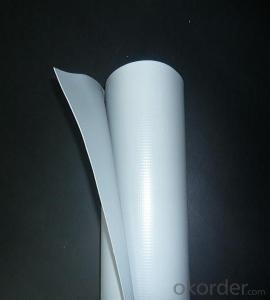Polyvinyl Chloride (PVC) Waterproof Membrane Nonwoven Polyester Reinforced
- Loading Port:
- China main port
- Payment Terms:
- TT OR LC
- Min Order Qty:
- 5000 m²
- Supply Capability:
- 100000 m²/month
OKorder Service Pledge
OKorder Financial Service
You Might Also Like
1. Brief Introdustion of PVC Waterproofing Membrane:
The P series waterproofing membrane is a heat-weldable membrane produced with an integral polyester reinforcement for high strength,for use in a Magical Stone's solution system. Its excellent performance of resistance to plasticizer extraction and migration, extend the product's life and more friendly to environment.
2. Specification of PVC Waterproofing Membrane
Length | 20m/roll or customized |
Width | 2.05m |
Thickness | 1.2mm; 1.5mm; 2.0mm |
Type | Homogeneous, Reinforced, Fabric back |
If Exposed | Exposed and Non-exposed |
Color | White, Grey or customized |
3. Introduction of PVC Waterproofing Membrane
Polyvinyl Chloride (PVC) waterproof membrane is a new polymer waterproof membrane which is made from polyvinyl chloride resin, and mixed with plasticizer, filler, antioxygen, ultraviolet absorber and other auxiliaries.
4. Features of PVC Waterproofing Membrane
1) Excellent aging resistance. Service life of roofing material is over 20 years;
service life of underground material is over 50 years.
2) Root resistant penetration, specially used on planting roof.
3) Welding installation. Joints are solid and environment friendly, no pollution.
4) High tensile strength, good elongation and dimensional stability.
5) Good plasticity, easy and suitable for details installation.
6) Fireproof. Fire extinguished out of the ignition resource.
7) Surface is smooth, no fading and dirty resistant.
5. Types of PVC Waterproofing Membrane
N1—Exposed PVC waterproof membrane.
(It is mainly used as details treatment for exposed roof waterproof project)
N2—Non-exposed PVC waterproof membrane.
(It is mainly used as details treatment for non-exposed roof waterproof project)
L1—Exposed PVC waterproof membrane with fabric.
(It is mainly used for exposed roof waterproof project)
L2—Non-exposed PVC waterproof membrane with fabric.
(It is mainly used for non-exposed roof waterproof project)
W1—Exposed reinforced PVC waterproof membrane .
(It is mainly used for steel structure roof exposed waterproof project)
W2—Exposed reinforced PVC waterproof membrane .
(It is mainly used for steel structure roof non-exposed waterproof project)
6. FAQ of PVC Waterproofing Membrane
a.Can we get some samples before place order?
Answer: We can send the free samples to you by freight collect.
b.How many years can your PVC membrane guarantee?
Answer: We will guarantee the quality for 5 years at least.
c.Which countries you ever export the product?
Answer: We export the PVC membrane to South Africa, Middle east and even European countries.
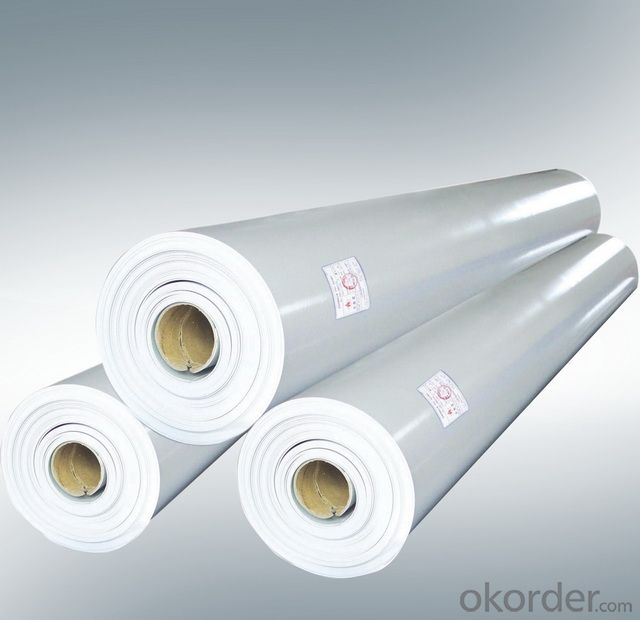
- Q: Can a waterproofing membrane be used for swimming pools or water features?
- Yes, a waterproofing membrane can be used for swimming pools or water features. A waterproofing membrane is designed to create a barrier that prevents water from seeping through and causing damage. This type of membrane is commonly used in various applications, including swimming pools and water features, to ensure that the water is contained within the designated area. It is important to choose a waterproofing membrane that is specifically designed for these purposes, as they are often formulated to withstand the constant exposure to water, chemicals, and other elements commonly found in swimming pools and water features. Proper installation of the membrane is crucial to ensure its effectiveness and longevity. Additionally, it is recommended to consult with a professional to determine the most suitable waterproofing membrane for your specific swimming pool or water feature project.
- Q: Can a waterproofing membrane be used in rooftop gardens or green roofs?
- Rooftop gardens or green roofs can benefit greatly from the utilization of a waterproofing membrane. It is, in fact, imperative to establish a dependable waterproofing system to safeguard the underlying structure against water-related harm. Acting as a hindrance, the waterproofing membrane effectively prevents any infiltration of water into the edifice or potential structural complications. Typically, this membrane is positioned beneath the soil or growth medium of the rooftop garden or green roof, guaranteeing adequate drainage and upholding the building's structural integrity. Furthermore, these membranes are specifically designed to endure exposure to UV rays, temperature fluctuations, and root intrusion, rendering them suitable for prolonged application in rooftop gardens or green roofs.
- Q: Can a waterproofing membrane be used for concrete tank linings?
- Concrete tank linings can make use of waterproofing membranes, which are frequently employed in construction to obstruct water penetration and offer a protective shield. By applying a waterproofing membrane to the inner surfaces of a concrete tank, the infiltration of water and subsequent harm can be effectively averted. This becomes especially crucial for tanks that store fluids or chemicals, as any leakage can result in contamination or structural decay. By utilizing a waterproofing membrane, the tank can be shielded against water ingress, guaranteeing its durability and preserving its structural soundness.
- Q: Can a waterproofing membrane be used for a swimming pool deck?
- A swimming pool deck can indeed utilize a waterproofing membrane. These membranes are widely employed in construction to thwart water infiltration. Their application is typically directed towards materials like concrete or wood, guaranteeing that water does not permeate and induce harm. By employing a waterproofing membrane on a swimming pool deck, where constant water exposure occurs, the underlying structure can be preserved and potential problems like water damage, decay, or mold growth can be averted. Moreover, the presence of a waterproofing membrane can boost safety for pool users by offering a slip-resistant surface.
- Q: Can a waterproofing membrane be used for a basement?
- Yes, a waterproofing membrane can be used for a basement. Waterproofing membranes are designed to prevent water infiltration and can effectively protect basements from moisture and potential water damage. They are typically applied to the exterior or interior walls and floors of basements to create a barrier against water seepage. This helps to keep the basement dry and protect against issues such as mold, mildew, and structural damage.
- Q: Can a waterproofing membrane be used for a hospital?
- Yes, a waterproofing membrane can be used for a hospital. Waterproofing membranes are commonly used in construction projects to prevent moisture infiltration and protect the integrity of the building materials. In a hospital setting, where hygiene and infection control are of utmost importance, it is crucial to maintain a dry and clean environment to prevent the growth of mold, mildew, and bacteria. A waterproofing membrane can help to create a barrier against water and moisture, preventing any potential damage to the structure and ensuring a safe and healthy environment for patients, staff, and visitors. Additionally, waterproofing membranes can also be used in specific areas of a hospital, such as operating rooms or laboratories, where the risk of spills or water exposure is higher. Overall, the use of a waterproofing membrane in a hospital can contribute to maintaining a high standard of cleanliness, safety, and durability in the facility.
- Q: Can a waterproofing membrane be used on brick walls?
- Yes, a waterproofing membrane can be used on brick walls. Brick is a porous material that can absorb water and moisture, making it susceptible to damage and deterioration over time. Applying a waterproofing membrane on brick walls helps to prevent water penetration and protect the structural integrity of the bricks. The membrane acts as a barrier, preventing water from seeping into the bricks while still allowing moisture to evaporate. This helps to keep the bricks dry and reduces the risk of water-related issues such as efflorescence, mold, and mildew. Additionally, a waterproofing membrane can also enhance the thermal insulation properties of the brick walls by reducing heat loss and improving energy efficiency. It is important to choose a waterproofing membrane specifically designed for use on masonry surfaces to ensure proper adhesion and long-lasting protection.
- Q: Can a waterproofing membrane be used for a school?
- Yes, a waterproofing membrane can be used for a school. Waterproofing membranes are commonly used in construction to prevent water penetration and protect buildings from moisture damage. Installing a waterproofing membrane in areas such as basements, roofs, or exterior walls can help keep the school building dry and safeguard against potential water-related issues.
- Q: Can a waterproofing membrane be used for walkways or pedestrian bridges?
- Yes, a waterproofing membrane can be used for walkways or pedestrian bridges. Waterproofing membranes are designed to protect surfaces from water infiltration and can be applied to various structures, including walkways and pedestrian bridges, to prevent water damage and ensure their longevity.
- Q: Are waterproofing membranes suitable for stadium structures?
- Waterproofing membranes are well-suited for stadium structures. Stadiums are exposed to different weather conditions, such as rain, snow, and humidity, which can potentially harm the structure if proper waterproofing measures are not taken. By providing a protective layer that prevents water infiltration, waterproofing membranes safeguard the stadium from moisture-related problems like leaks, mold, and corrosion. Water accumulation on large roof areas and expansive seating areas is common in stadium structures, making waterproofing essential. Membranes can be applied on various surfaces, such as concrete, metal, and wood, offering a versatile and effective waterproofing solution for stadiums. Furthermore, waterproofing membranes offer durability and longevity, which is crucial for stadiums that experience heavy usage and constant exposure to the elements. They are designed to withstand thermal expansion and contraction, as well as UV radiation, ensuring long-term protection for the structure. Moreover, architects and engineers can customize waterproofing membranes to meet specific design requirements, seamlessly integrating them into the stadium's overall aesthetic. These membranes come in various colors, textures, and finishes, allowing them to blend with the surrounding materials and enhance the stadium's visual appeal. In conclusion, waterproofing membranes are a reliable and effective solution for protecting stadium structures from water damage. They provide durability, versatility, and customization options, making them suitable for any stadium construction or renovation project.
Send your message to us
Polyvinyl Chloride (PVC) Waterproof Membrane Nonwoven Polyester Reinforced
- Loading Port:
- China main port
- Payment Terms:
- TT OR LC
- Min Order Qty:
- 5000 m²
- Supply Capability:
- 100000 m²/month
OKorder Service Pledge
OKorder Financial Service
Similar products
Hot products
Hot Searches
Related keywords
